人教版高中英语必修二第四单元 Unit4 Wildlife Protection warming up
- 格式:ppt
- 大小:11.59 MB
- 文档页数:62

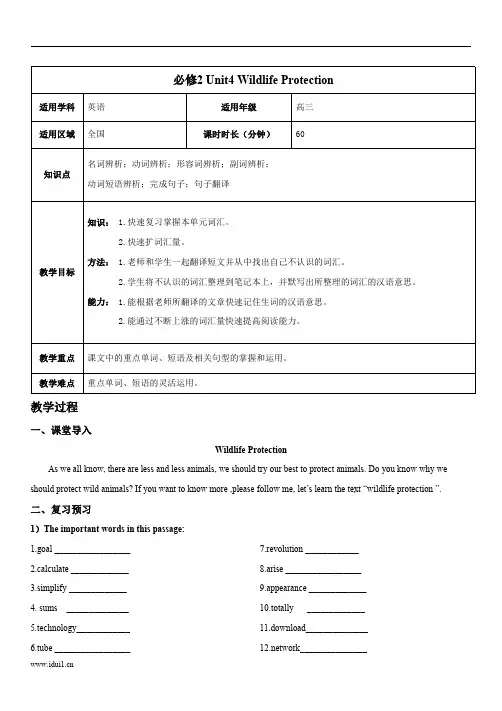
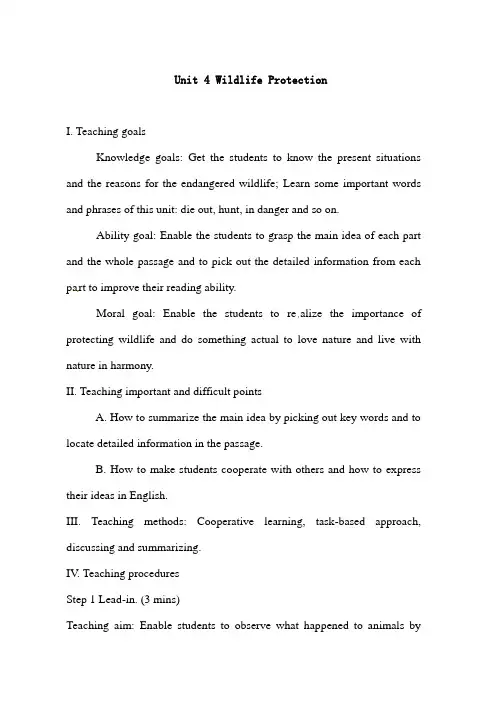
Unit 4 Wildlife ProtectionI. Teaching goalsKnowledge goals: Get the students to know the present situations and the reasons for the endangered wildlife; Learn some important words and phrases of this unit: die out, hunt, in danger and so on.Ability goal: Enable the students to grasp the main idea of each part and the whole passage and to pick out the detailed information from each part to improve their reading ability.Moral goal: Enable the students to re alize the importance of protecting wildlife and do something actual to love nature and live with nature in harmony.II. Teaching important and difficult pointsA. How to summarize the main idea by picking out key words and to locate detailed information in the passage.B. How to make students cooperate with others and how to express their ideas in English.III. Teaching methods: Cooperative learning, task-based approach, discussing and summarizing.IV. Teaching proceduresStep 1 Lead-in. (3 mins)Teaching aim: Enable students to observe what happened to animals byenjoying a song.Greet students as usual.Firstly let’s enjoy a MV (Earth Song by Michael). Pay attention to animals in this music video. (What happened to animals? )T: Boys and girls, does animals live a happy life in this music video?Ss: No!T: Ok, now let’s look at some pictures.Step 2 Warming-up. (3 mins)Teaching aim: Enable students to realize that too much hunting by people is the most important reason for animals’ dying out through some pictures and a question.Picture 1: This is an Tibetan antelope which is very rare. People kill them for their fur, skin and meat.Picture 2: South China Tiger. They are searching for food which means they don’t have a good habitat.Picture 3: Elephant. People kill elephants for their ivories, which are very dear. The ivory has been traded among foreign countries.T: Here we must think about a question: why are these a nimals dying out?Ss: Hungry, hunting......T: More pictures......Therefore, the most important reason for their dying out is too much hunting, by whom?Ss: By people.T: Right. Good!Step 3 Pre-reading. (2 mins)Teaching aim: Import students into the passage--How Daisy Learned to Help Wildlife quickly.T: Then as middle students, certainly we should protect these miserable animals. What should you do?Ss: Plant trees; eat less animals;......T: You are so good. Now everyone, please open your books and turn to P.26. This class we will discuss how Daisy, a little girl, learned to help wildlife.Step 4 Reading. (19 mins)Teaching aim: Enable the students to grasp the main idea of each part and the whole passage and to pick out the detailed information from each part to retell the passage.1)Analyzing pictures. (2 mins)T: How many pictures are there in this passage?Ss: Two.T: Picture 1 is an Tibetan antelope. Picture 2 is about elephants. 2)Listening. (4 mins)Teaching aim: Enable students to listen to the passage based on two questions.According to the two questions, listen to the whole passage and try to underline these answers in the passage.a. Is there any other animal in this passage? If there is, what is it?b. How many places did Daisy travel? What are they?......T: Check answers on the blackboard. (Animals: antelope, elephant and monkey; Places: Tibet, Zimbabwe, and rainforest) But how did Daisy go to these places and see these animals?Ss: A flying carpet.T: Good, she took a flying carpet to these places. Based on these clues, we can divide the passage into 3 parts. (para.1/para.2/para.3-4)3)Skimming. (5 mins)Teaching aim: Enable students to match the main idea of each part by skimming.T: This passage is a story, so we can’t pick out the topic sentence in each part. Then we need to summarize the main idea of each part, but how? Depend on what?Ss: ......T: Key words. Do you still remember? Look at these three sentences in the screen and pick out key words in each sentence. (S1: antelopes; why. S2: get a lot. S3: elephant; good example.) Now finish the task. Three minutes for you.......Check answers. (Ask some student to show his or her ideas.)Para 1: The story of antelopes tells us why we need wildlife protection.Para. 2: The story of elephants is a good example of wildlife protection.Para. 3-4: We can get a lot from wildlife protection.T: All of you did a good job. So here we can summarize the main idea of the whole passage. Look at the screen and fill in the blanks. Together, ok?Ss: In Daisy’s dream, she took a flying carpet to travel and met different animals, which made her realize the importance of protecting wildlife.T: Well done!4)Detailed reading. (8 mins)Teaching aim: Enable students to make a detailed reading about the passage to improve their reading ability.T: Now let’s do something interesting. A competition for you--detailed reading. But how to make detailed reading?Ss: Find information in the passage......T: Right, but imperfect. Look at the screen and read these together. One, two, go.Ss: Locate the key words into the concrete position in the passage, and then look ahead and behind until you find the answers.T: Two points. “Locate”and “look ahead and behind”. Now use this method to read the passage in detail. Three charts for you, about 6 minutes. You are to discuss in groups of six and I will ask some groups to share their answers. Now, begin!Chart 1(para.1):Ask some representatives to check answers. Then read the three sentences together to briefly summarize para.1.Chart 2(para.2):Ask some representatives to check answers. Then read the three sentences together to briefly summarize para.2.Chart 3(para.3-4)powerfuAnswer these questions together and all the boys read these sentences.Evaluate students: Most of you did a good job in this task. So congratulations, my dear boys and girls (clap hands). Pay attention to the method especially when you meet so many new words.Step 5 Summarize. (3 mins)Teaching aim: Enable students to make a brief summary of the passage based on the blackboard design.Make a summary of the whole passage based on the blackboarddesign from the left to the right (the title, animals, places, how to go, main idea of each part and of the whole passage).Step 6 Retell the passage. (5 mins)Teaching aim: Make students retell the passage to examine whether they have grasped this passage.Fill in the blanks. One passage by one. Then ask some volunteers to share their answers.(One day Daisy went to see the animals that gave fur to make her sweater in a flying carpet. It flew away to Tibet in China first, where she saw an antelop e. The antelope told her that they were killed (kill) for the wool.Then they went to Zimbabwe, where Daisy saw an elephant. Farmers used to hunt them without mercy. Now they allowed tourists to hunt only a certain number of animals if they paid the farmers. The problem was solved.In the thick rainforest, a monkey was rubbing a millipede insect which contains a powerful drug to protect (protect)him from mosquitoes. So Daisy decided to produce this new drug with the help of WWF. The carpet rose and flew home.)Step 7 Write a letter. (10 mins)Teaching aim: Enable students to understand how to write a proposal letter so that they can provide some actual advice to protect wildlife topractice their writing ability.1). 假设你是小明,学习本课后,对于中学生如何保护野生动植物有自己的看法,现请你向WWF写一封信,提出几点关于野生动植物保护的建议,并期待他们的回复。
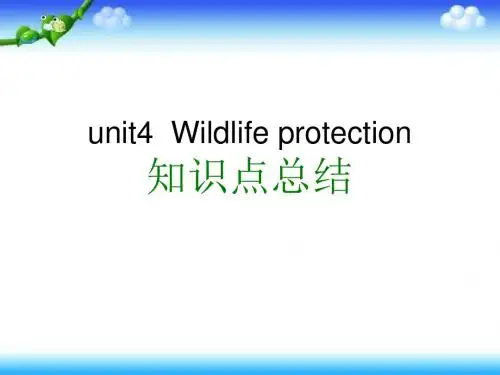

Unit 4 Wildlife ProtectionUsing language (listening,speaking and writing)Design concept: the design is about Senior English for China book 2 unit 4 Wildlife protection; this is the Fifth period of this unit teaching, so it’s mainly about listening, speaking and writing. In this design, there are living environments to help students to apply their knowledge to practice and all the activities are centered on the students; besides, the activities are set from easy to difficult, and they are suitable for students of different levels. It is aimed to make students learn happily, experience the happiness of success and improve their abilities of listening, speaking and writing.Part one: Teaching aimsBy the end of this class, the majority of the students will be able to reach these goals.1. Knowledge aims(1). The students will be able to express their intention and purpose.(2). The students will be able to make sentences with the new words andexpressions in this unit.2. Ability aims(1). Through listening, students will improve their listening ability, especially the ability to catch key words and the ability to analyze the information.(2).Students will be able to talk about the endangered animals and the ways to protect them.(3). Through writing practice, Ss will be able to improve their writing skills.3. Emotional aims(1). Stimulate students’ love for wildlife.(2). Cultivate students’ sense of cooperation and build up their confidence in learning English.Part two: The analysis of studentsAccording to the New Standard Curriculum and the New Syllabus and the artistic appreciation, students in grade one are supposed to learn to be independent and cooperative in learning; besides they should learn to find out questions, analyze questions and work out questions in English; meanwhile they are requested to form the habit of thinking in English. My students have just graduated from junior school, they are able to deal with some easy questions, so in this period, I want to help them to listen independently, discuss together and solve difficult questions by teamwork.Part three: The analysis of the teaching materialThe teaching content is from New Senior English For China Module 2, Unit 4 Wildlife protection. This is the fifth period of this unit, which is about the listening, speaking and writing. This unit is about wildlife protection. From learning this period, the students can apply what they have learnt to talk and write, so this period is very important in this unit teaching and learning it well is a must for the students.Teaching important and difficult points:Improve the students’listening ability, especially the ability to catch key words and analyze the information. Improve the students’ writing skills (the ability to “output”after listening and speaking.Part four: teaching conceptsTeaching serves students, so all the activities are centered on students. In the class, the teacher is a guide and helper. Because each student has his own strengths and weakness, and they may not at the same English level, the teacher should set questions of different levels to make every student feel the happiness of development and help them to experience success. Part five: teaching strategiesAccording to the artistic appreciation, the purposeof teaching English is to improve their abilities of language learning, develop their spirit of teamwor k, and help them to learn by themselves. Through listening and speaking, students get the content of writing and get the ideas organized, which makes the writing task easier. So in this period, all the activities are for the students, so the teacher should communicate with students, observe their emotions and make proper adjustment in the class.Part six: teaching environmentEnglish class is the only time when students can practice listening and spoken English, so in the class the students and teachers will mainly use English to learn and communicate. Of course, if the students have difficulty in understanding, I will translate them into English to help them cooperate well. Part seven: Teaching proceduresStep 1. Revision and goals introductionIn this Unit, we talked about wildlife protection, so we know lots of animals are dying out, and also plenty of animals have already disappeared. Today we have some new goals and tasks, so let’s learn it together. Purpose: Make the students be clear about the tasks in this class, and be more careful in learning.Step 2. ListeningTask 1. Wake up your earsPlay a game with the students to arouse their attention about listening.Purpose: attract the students’ attention and make them more careful in listening .Task 2. ListeningActivity 1. Before listeningLook through the questions in listening part, and predict what the listening material is about. Purpose: make the students be prepared for the listening exercise.Activity 2. while listeningLead the students to form the habit of grasping the important words and making notes when listening.For the first time, the students should do Exercise 1 to catch the main idea.For the second time, finish all the exercises on page 30. and try to check their answers.For the third time, ask the students to try to get more details. Activity 3. After listeningHelp the students try to retell what they have listened in their own words. Purpose: help the students get some informationthrough listening .Step 3. SpeakingActivity 1: Free talkCan you list any endangered animals?( Show some pictures to help students know about their present situation and the reasons why they are in danger. )Activity 2. Discussion1. Why are they in danger?2. What should we do to protect these endangered animals? (several minutes later, ask some volunteers to present their ideas.)Purpose: input some content and be prepared for the writing . Step 4. WritingWrite a letter to WWF based on what you have discussed, asking them tohelp save the endangered animals.Firstly, review the start and the end of a letter, be clear about the form of a letter.Secondly, plan the structure of the letter together.Dear xxx,para1: the present situationpara2: the reasonpara3: the measurespare4: conclusion or an appeal yours sincerelyxxx Thirdly, offer some useful expressions to help them writing.Para1: I am writing to…Para2: As we all know, The number of …There are many reasons why… Firstly ,…; secondly, …;thirdly,…Para3: It is time to … take measures to do Above all ,…;Besides, …;what’s more,… It’s a good idea to do… why notdo…?We had better do… We are supposed to doPara4: take action make a difference to… live inharmony withPurpose: give some supporting languages to help them expresstheir ideas freely.Then ask the students to write the letter individually.…..Give an evaluation standard, after the students finish writing,If there are different paragraphs to express your ideas.If there is a topic sentence in each paragraph.If the ideas are organized logically.If the tense and person are used correctly.If your expressions are used properly and vividly.If your handwriting is neat and easy to read.Then, ask students to swap with their desk mates to correct the mistakes.Purpose: make the students know about the writing standard, and learn to find mistakes during learning.Step 5. SummaryAsk the student on duty to make a summary of this period. Step 6. HomeworkPolish your own composition and write it on your exercise. Review this unit and do the exercises in your workbook. Step 7. Reflection after classIn this class, my students are the center, I designed various activities to try to make students involved in the whole class and improve their English learning During listening teaching, I lead them to catch key words and analyze the information. . From listening and discussing, students will make the writing task easier. Through writing, students have improved their writing skills. So from this class, the students form the habitof thinking individually and learning corporately, they have practiced their listening, speaking and writing ability, and improved their English learning. Therefore, this class has reached its original aims and it is a success品味人生1、不管鸟的翅膀多么完美,如果不凭借空气,鸟就永远飞不到高空。
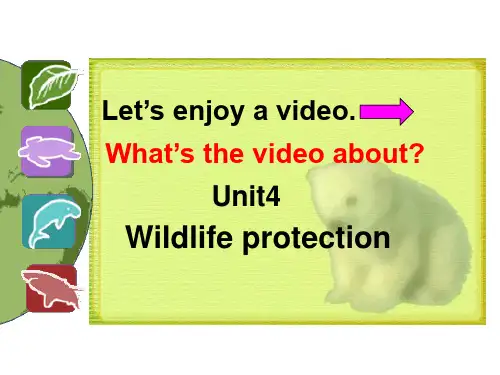
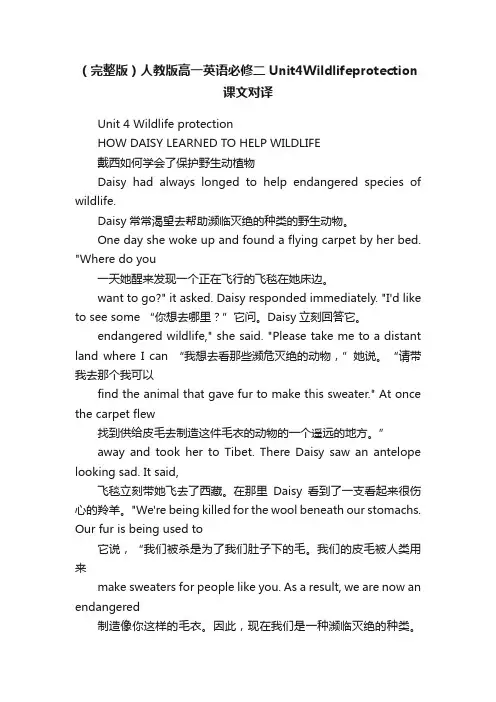
(完整版)人教版高一英语必修二Unit4Wildlifeprotection课文对译Unit 4 Wildlife protectionHOW DAISY LEARNED TO HELP WILDLIFE戴西如何学会了保护野生动植物Daisy had always longed to help endangered species of wildlife.Daisy常常渴望去帮助濒临灭绝的种类的野生动物。
One day she woke up and found a flying carpet by her bed. "Where do you一天她醒来发现一个正在飞行的飞毯在她床边。
want to go?" it asked. Daisy responded immediately. "I'd like to see some “你想去哪里?”它问。
Daisy立刻回答它。
endangered wildlife," she said. "Please take me to a distant land where I can “我想去看那些濒危灭绝的动物,”她说。
“请带我去那个我可以find the animal that gave fur to make this sweater." At once the carpet flew找到供给皮毛去制造这件毛衣的动物的一个遥远的地方。
”away and took her to Tibet. There Daisy saw an antelope looking sad. It said,飞毯立刻带她飞去了西藏。
在那里Daisy看到了一支看起来很伤心的羚羊。
"We're being killed for the wool beneath our stomachs. Our fur is being used to它说,“我们被杀是为了我们肚子下的毛。

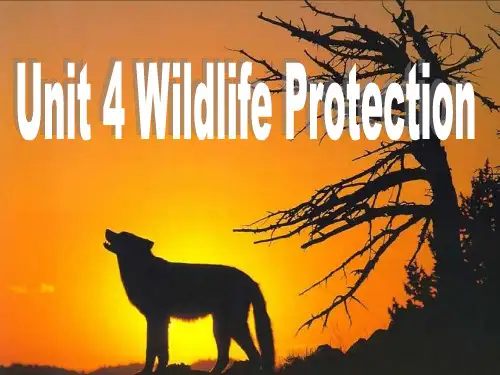

Unit 4 Wildlife protectionTeaching aims:1. TopicWildlife protection: the importance of wildlife protection, ways to protect wild plants and animals.2. Useful words and expressions:wild wildlife protection enemy loss reserve area hunt zone peace fur stomach apply suggest thick rub mosquito insect contain powerful drug affect attention whale bite effect butterfly dust recently fierce unkind lazyas a result die out in peace in dangerprotect… from pay attention to come into being3. Functional items:I. Intentions and purposeI’m going to do…I feel like doing..I would rather not…I intend/ mean/ plan to do…I’d like to do…I will do…I’m ready to do….II. ApologiesI’m so sorry that..I’m afraid that ….Thank you very much but..It’s a shame that …It was very nice of you but…4. StructuresThe present continuous passive voiceAnimals are being hunted and killed.The environment is being destroyed.Teaching proceduresPeriod 1. Speaking and listeningStep 1. Leading in1. Show Ss a video about some animals in danger.2. Show Ss some picture of some rare animals in China.Step 2. Warming up1. Ss read the passage quickly and find out:Why did so many wild animals die out?2. Ss talk about the form on page 25 and then discuss the following questions in pairs.1). What other endangered species do you know?2). Why are they in danger of disappearing?3). Do you know any wildlife that has disappeared?Step 3. Listening and talking (page 62)1. Ss look through the questions on page 62, and then listen to the tape.2. First listening: Ss listen and grasp the key words and get the main idea.3. Second listening: Ss listen and answer the questions.4. Third listening: Ss listen and write down the main idea of the passage.5. Talking: Ss read the topics on page 62 and discuss in pairs. While they are talking, try to use the following sentences:I’m so sorry that…I’m afraid that…Thank you very much but…I hate to have to say this but…The problem is….It was very nice of you but…It’s a shame that …Why didn’t you tell me that..?Homework1. Collect as much information about endangered wildlife as possible.2. Preview the next part—readingPeriod 2. ReadingStep 1. RevisionAsk: What do you think of wildlife protection today?What’s the passage about? Have you previewed it?Step 2. Pre-readingSs in groups discuss the following questions:1. Why should you worry about this?2. What do you think we should do to protect wildlife?Step 3. Reading1. Scanning: Ss read the passage quickly to get the main idea and complete the table on page 27.2. Intensive reading: Ss read the passage again and answer the questions on page 27.Step 4. Explanation1. as a result of2. die out3. rise (v)4. affect5. prevent …from6. She turned round and there was an antelope with a sad face looking at her.7. In three years they may all be gone!8. But what an experience!Homework1. Recite the key sentences in the text.2. Write a summary of the text.Period 3. Extensive readingStep 1. RevisionSs completer the summary of the text.One day, Daisy _____ a strange dream. She flew in a wonderful ______ to _____ with an _______ in Tibet. The antelope told her they were hunted because of their_____ which can be used to make ______ like hers. In three years they may all be ______ . Later, she _____ to Zimbabwe where she talked with an ______ and got to know the farmers there no longer ______ them. That’s because the _______ decided to help and the farmers finally made a lot of ______ . At last she _____ at the thick rain _____ where a monkey told her “No rain forest, no ____ and no ____.”Although finally everything was _____, she had _____ so much!Answers:dreamed, chair, talk, antelope, fur, sweaters, gone, flew, elephant, hunted, government, money, arrived, forest, animals , drugs, gone, learnedStep 2. Pre-reading1. Ss talk about what they know about the animals.2. Ss read the passage and get the main idea.Step 3. Reading (page 30)1. Check Ss’ answer.The main idea is species and the reasons for dinosaurs’ dying out.2. Ss read again and find out answers to the following questions:1). When did the dinosaurs live?2). What’s the rare new species dinosaur?3). Why did the dinosaur die out?Step 4. Reading task (page 65)1. Ss read the passage on page 65 and try to collect information for research into Milu deer.2. Ss discuss the information collected with their partner and then check themwith the whole class.HomeworkDescribe dinosaurs and Milu deer in your own words.Period 4.Learning about languageStep 1. RevisionSs try to say something about dinosaurs and Milu deer in their own words.Step 2. Practicing the useful words and expressions1. Ss finish Ex 1 and 2 on page 28.2. Check the answers with the whole class and talk about the important phrases.1). apply for sth. /apply to do sth2). Bite-bit-bitten3). Have an good/bad/no effect on …= affect4). Pay attention to : “to” is a prep. Here.Step 3. Structure learning: the present continuous passive voice1. Ss read the following sentences and try to find the rules1). Out fur is being used to make sweaters like yours.2). The environment is being destroyed.2. Ss finish Ex 2 on page 29.3. Play a game.Step 4. Practicing (page 63)1. Ss finish Ex 1 and2.2. Check the answers with the whole class.Step 5. Using structures1. Ss do Ex 1 on page 64 and pay attention to the structures of the present continuous passive voice.2. Tell Ss to remember the following expressions;…is under repair = …is being repaired…is under discussion=…is being discussedHomework1. Review what they have learnt about the present continuous passive voice.2. Finish Wb Ex 2 on page 64.Period 5. Using languageStep 1. RevisionCheck Ss’ homework.Step 2. Listening (page 30)1. Ss listen to the tape about a disappearing animal. Go through Ex 1 before listening.2. Play the tape again and check the answers.Step 3.Speaking (page 31)1. Ss talk in pairs about what they can do to help the lovely dodo.Step 4. WritingSs write the letter independently.Some writing tips:1. Collect your idea for the letter. Write an outline of your ways to help it.2. Decide the intention and the purpose of each of your ways.3. Begin your letter with your address and the solution. Then write the ways as the body of the letter.4. Finish the letter with your best wished and your signature.HomeworkSum up what you have learnt in this unit.Period 6. Integrating skillsStep 1. RevisionReview what they have learnt in this unit.Step 2. Listening (page 66)Ss listen to three letters and see if they can help to answer them. While listening, fill in the boxed on page 66.Step 3. SpeakingWork in pairs and try to talk about what advice you might give to one of the three writers.Tips:1. Look through the three problems and decide which one to answer.2. Write notes of your idea.3. Give reasons for your idea.4. Talk about them with your partners and then share your opinions with the whole class.Step 4. Writing (page 67)Ss write down their ideas in the form of a letter. Make each idea into one paragraph. And then exchange the letters with their partners to check.Step 5. Project (page 67)1. Ask the Ss to read the directions.2. Direct the Ss to prepare a project.As a student, what will you do to improve the environment?HomeworkFinish the project on page 67.Period sevenTeachers can use this period freely.Suggestion: Teachers can use this period to let Ss sum up what they have learned and explain what Ss couldn’t understand very well in this unit. Teachers can also add more practice in this period to consolidate what the Ss have learned. Finally, ask the Ss to finish checking yourself. It is very important to improve their learning.。
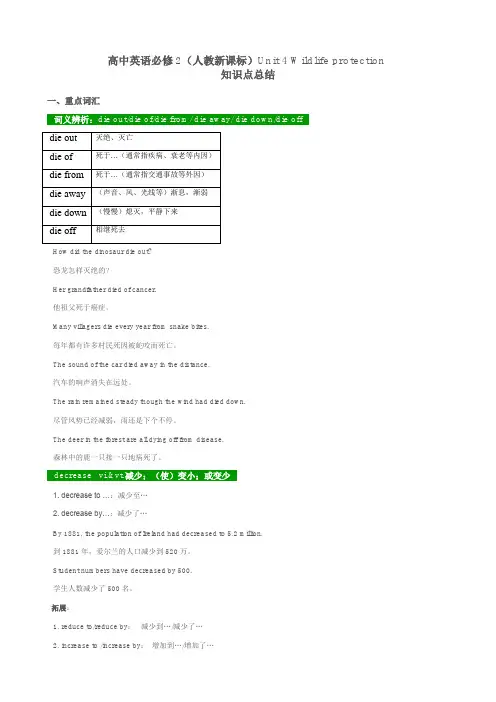
高中英语必修2(人教新课标)Unit 4 Wildlife protection知识点总结一、重点词汇How did the dinosaur die out?恐龙怎样灭绝的?Her grandfather died of cancer.他祖父死于癌症。
Many villagers die every year from snake bites.每年都有许多村民死因被蛇咬而死亡。
The sound of the car died away in the distance.汽车的响声消失在远处。
The rain remained steady though the wind had died down.尽管风势已经减弱,雨还是下个不停。
The deer in the forest are all dying off from disease.森林中的鹿一只接一只地病死了。
decrease vi.&vt.减少;(使)变小;或变少1. decrease to …:减少至…2. decrease by…:减少了…By 1881, the population of Ireland had decreased to 5.2 million.到1881年,爱尔兰的人口减少到520万。
Student numbers have decreased by 500.学生人数减少了500名。
拓展:1. reduce to/reduce by:减少到…/减少了…2. increase to /increase by:增加到…/增加了…1. be certain of/ about sth.:对…有把握(=be sure of/about sth.)2. be certain to do sth.:一定会做…3. a certain amount of:一定量的4. to a certain extent:一定程度上5. It is certain that…:肯定,一定会….(不能说It is sure that…)She is a confident woman who is certain of her views.她是一位充满自信的女性,对自己的观点深信不疑。
Unit 4 Wildlife protectionHOW DAISY LEARNED TO HELP WILDLIFE戴西如何学会了保护野生动植物Daisy had always longed to help endangered species of wildlife.Daisy常常渴望去帮助濒临灭绝的种类的野生动物。
One day she woke up and found a flying carpet by her bed. "Where do you一天她醒来发现一个正在飞行的飞毯在她床边。
want to go?" it asked. Daisy responded immediately. "I'd like to see some “你想去哪里?”它问。
Daisy立刻回答它。
endangered wildlife," she said. "Please take me to a distant land where I can “我想去看那些濒危灭绝的动物,”她说。
“请带我去那个我可以find the animal that gave fur to make this sweater." At once the carpet flew找到供给皮毛去制造这件毛衣的动物的一个遥远的地方。
”away and took her to Tibet. There Daisy saw an antelope looking sad. It said,飞毯立刻带她飞去了西藏。
在那里Daisy看到了一支看起来很伤心的羚羊。
"We're being killed for the wool beneath our stomachs. Our fur is being used to它说,“我们被杀是为了我们肚子下的毛。
Unit 4 Wildlife Protection I. 单元教学目标II. 目标语言II. 教材分析与教材重组1. 教材分析本单元以保护动物为话题,旨在通过本单元的学习使学生了解很多动物已经灭绝或濒临灭绝,从而认识到保护动物的重要性和必要性;通过探讨保护动物的措施和建议,引导学生发表自己的见解和看法;通过进一步讨论提出有效的保护措施,唤起学生保护动植物、维护生态平衡、保护我们家园的责任感。
并能写信表达自己保护动物的方法与建议,力求正确表达自己的意图并解释原因,并能正确使用被动语态的现在进行时。
1.1 Warming Up首先帮助学生明确保护野生动物的原因以及方向。
旨在通过图片和表格引导学生讨论当今我国珍稀动物的现状。
以panda、Milu Deer、South China Tiger 为例,通过对这些珍惜动物所面临的问题、在中国的栖息地以及采取措施其后对比所做的报告,学生能够用已有的知识和经验讨论在中国处于保护状态下的濒临灭绝动物。
从而有效地引导学生关注本单元话题,关注动物生存现状。
1.2 Pre-reading是Reading的热身活动。
通过回答两个问题引导学生讨论自己所知道的濒临灭绝的动物并思考灭亡的原因。
同时要求学生通过阅读文中的图片和标题来猜测文章的内容。
1.3 Reading是一篇童话故事,讲述Daisy 乘坐飞毯跨越时空,在不同个国度、不同地区与生存状态不尽相同的和藏羚羊、大象、猴子对话的神奇经历,展示了Daisy逐渐认识保护动物重要性以及学习如何保护动物的经历。
动物们讲述了各自的处境,唤起了Daisy对动物的热爱以及保护动物的责任心。
从而号召人们热爱动物,保护动物,从我做起。
1.4 Comprehending考察学生对阅读内容的进一步理解与对所学知识的综合运用、迁移。
练习1要求学生根据阅读文的内容回答问题。
这四个问题设计到濒临物种生存现状,保护这些物种所取得成效的措施、保护动物栖息地的重要性以及决定保护成果能够的必要措施。